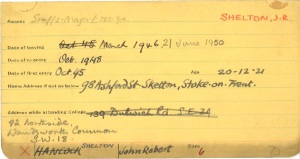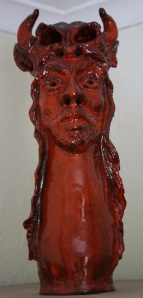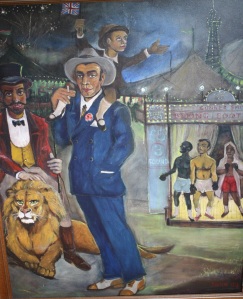John Shelton (Hancock); Stoke-on-Trent, 1923-1993
John Hancock was raised in Shelton, Stoke-on-Trent in Ashford Street. In his own words:
“Born April 1923 in Stoke, Staffordshire. Father a coal miner, mother a school teacher. No formal early education due to poliomyelitis until the age of ten at Cauldon Road Primary School, Shelton. From there, aged fourteen, gained a scholarship to the Junior Art Department of the Burslem School of Art.“
In 1939, John gained entry to the Senior Art Department until 1941 when he left to work as a clerk for the Ministry of Manpower. After more subsequent war-related work for British Small Arms he rejoined Burslem School of Art. 1942: “Rejoin Arthur Berry, Norman Cope, Bill Bowyer and young Alf Hackney, Betty Knapper [and] Monica Goddard at Burslem School of Art. Full Time Student (Sept.). R.G. Haggar has taken over from G.M. Forsyth and is Acting Principal. Pass Board of Education exams [in drawing and painting]“. The following year saw Shelton awarded a scholarship for the Slade School of Fine Art, London which he attended from 1945. Shelton’s notes from that year chronicle his life in the London art scene of the time, providing his own perspective on the London years as told by Arthur Berry in A Three and Sevenpence Halfpenny Man1:
“With Arthur Berry I meet Colquhoun and MacBryde and also Minton and Jankel Adler at 77 Bedford Gardens, Nottinghill… Berry and [I] frequent Fitzrovia in their company for the next few years. In their company meet Vaughn and Dylan Thomas, David Archer and others of the loose Soho Society. On the excuse (though it was true) we gate crash artists’ studios looking for help in finding a studio of our own. Meet Felix Topolski (Bayswater) this way and Graham Sutherland at Wimbledon.“
John left the Slade in March 1946. His diary for the following year states:
“1947…
I spend 12 months in Ramsgate family home of the Knights. Teach part-time evenings at Broadstairs St. Stephen’s Convent School, North Gorelands [and] also attend Margate School of Art. Mural painting commissioned [at] Thannet Hotels partnered by Denis Knight. Change name from Hancock to Shelton at Ministry of Employment under [an] act brought in to accommodate refugee immigrants.“
The name change had been brought about by a row with his father, Robert. John returned to the Slade – as John Shelton – to complete his scholarship in the two years from 1948-50.

Shelton Knight Studios, 237 Vauxhall Bridge Road, SW1
1950: “Forget to attend Slade anymore. Work at Lambeth Town Hall, Electorial Registers. Move to 82 Northside, Wandsworth Common. Paint still lifes influenced by Braque. Make monotypes after RC. Work Lambeth Goods Station.” A 1951 oil most likely depicts the view from 82 Northside which was described by Shelton as a “five roomed flat, two floors with [a] large back studio [at] only £4 per week. Bookies premises on ground floor.“
1951: “I work at Amphitheatre, Festival Gardens, Battersey Park. Start silk screen ceramic transfer printing business with D. Knight at 6 Moreton Terrace Mews, Vauxhall Bridge Road, Victoria.“
1952: Shelton travelled back and forth between London and the Potteries to get orders for the silk screen ceramic transfers.
1953: “John Law becomes third man in Shelton/Knight Studio business. Things not going very well… Tempers frayed. Who are we, where do we come from, where are we going? I work on coloured monotypes Colquhoun style. Few paintings.” By 1954 the business had failed and Shelton left Wandsworth to return to Stoke-on-Trent where he lived in at 227 Newcastle Street, Burslem, described as “an old cottage shop“.
1956-57
“Meet Vera Cornes at Spode China Co… Meet Arthur Berry again in Burslem and we take on a house together with a studio apiece. Mine ground floor, Vera lives with me.“
Shelton adopted a wide variety of styles during his career. Earlier works – monotypes such as ‘Keggy Dart Thrower’, ‘City Rosette Seller’ (1958) and ‘Humbug Seller & Child’ (1958) – show similarities in style with Berry – being produced at the time the two of them shared the studio on Porthill Bank. These are dark and emotive pieces revelling in the gritty urban characters populating the streets of Stoke-on-Trent. His use of the monotype in 1945 while staying in London with Berry (and under the artistic influence of the Two Roberts) is noted as being early on in the re-use of the technique in the mid 1940s in the London art scene gravitating around Colquhoun and MacBryde.
Shelton was also a prolific pottery-maker and the influence of Picasso can be seen through the many minotaurs he produced, as well as in drawings such as ‘Europa & Bull II’. Greek mythology was prevalent in many of Shelton’s ceramic pieces; Theseus, the Minotaur and the centaur were common subjects. This same theme is evident in a handful of Shelton’s paintings such as the Picasso-esque ‘Cat at a Table 2 with Theseus Head’.
A Sentinel review of a Brampton exhibition (circa 1970) by Shelton’s ex-tutor Reginald Haggar noted that “he was one of a richly endowed bunch of students who have gone on to enrich the tradition of oil and watercolour painting in this country and the field of art teaching.” Robert Colquhoun and Robert MacBryde were cited in this article as being two of Shelton’s influences, along with Graham Sutherland. A picture of The Two Roberts still hangs on Shelton’s studio wall. At the time of the Haggar review, Shelton was art master at the Newcastle School of Art in Sidmouth Avenue, alongside Jack Clarkson who was principal. Former students of that school include artists such as David Harris (1972-75).
Just as one of his influences, Braque, had at times adopted a Fauvist style – whereby brilliant colours were used to represent emotional response – Shelton’s later pieces such as “Night Out With Robert – My Father And Me in 1928” (1988) and “Above the Trent & Mersey Canal” (1988) were produced in flamboyant brilliance. The latter of these works featured Shelton’s aunt – purported to have “danced her husband to the grave” – and her husband, floating above a Potteries city-scape. 1988 turned out to be a prolific year for paintings as an homage to French surrealist Felix Labisse’s Prodigal Daughter was also produced. Shelton was working on the companion piece – his own version of the Prodigal Daughter – at the time of his death in 1993; a female form stands before a waterscape, while Labisse’s black bird is replaced by a white gull. References to subject-matter of other Shelton works are also evident – namely a clown and a violin.
When Shelton painted his “Night Out With Robert – My Father And Me in 1928” in his later years, did he have feelings of reconciliation towards his father or is the message on the back of the canvas, seemingly about the lion tamer, alluding elsewhere?
“MY FATHER TO TROJAN THE LION TAMER
RECKON IT’S ALL DONE BY KINDNESS?
TROJAN – YEAH – I GIVE ‘EM A DAMNED
GOOD HIDING EVERY THURSDAY”.
The painting is most likely an idealised memory of his childhood – it is set in 1928, the year before John contracted polio which left him crippled for the remainder of his life. The setting is most likely the Wakes Ground, Hanley, although artistic licence saw Shelton embellish the background with more prominent landmarks – namely the Blackpool Tower. His later works saw Shelton start to sign his pieces as “John”, moving away from the firmer assertion of Hancock or Shelton. I feel that these pieces are ones of reconciliation and echo the sentiment in his diary that his name change was done at haste after the row with his father in his youth.
John Shelton died shortly after his 70th birthday in 1993. His work is in the National Collection (recently published online via the BBC Your Paintings project) and is in private collections including those of the actor Freddie Jones and the late Pat Phoenix. The Brampton gave a retrospective of around sixty of Shelton’s works in 1983. This forgotten son of Stoke-on-Trent who – according to the Haggar review – was “content to plough a lonely furrow in North Staffordshire” still has a cutting on the wall of his studio referencing a Cyril Connolly quote from the last issue of Horizon (December 1949):
“…an artist will be judged only by the resonance of his solitude or the quality of his despair.“
FOOTNOTE
1John Shelton is the same John ‘with the gammy leg’ from the Slade as referenced in Arthur Berry’s A Three and Sevenpence Halfpenny Man.
Thanks to Paine Proffitt for his own insight into John Shelton’s work.
-
March 19, 2012 at 9:44 pmReginald’s riposte – Sentinel review of John Shelton exhibition « finbofinbo
-
April 4, 2012 at 4:35 amDEATH OF ART STUDENT – FALL DOWN STAIRS « finbofinbo
-
May 7, 2012 at 2:02 pmThe Burslem Boys – Art Exhibition, Stoke-on-Trent; 19-26 Oct. 2012 « finbofinbo
-
August 31, 2012 at 5:55 pmOn the trail of Michael Paffard « finbofinbo
-
November 8, 2012 at 8:57 pmIs this Fitzrovia? « finbofinbo
-
November 22, 2012 at 9:43 pmThe Ashford Street Stanzas (A Staffordshire miner’s lament) « finbofinbo
-
December 23, 2012 at 2:47 pmThe oil paintings of John Shelton (1923-1993): an ongoing catalogue « finbofinbo
-
January 1, 2013 at 10:16 pmTwenty lost prints by John Shelton (1923-1993) « finbofinbo
-
January 3, 2013 at 6:59 pmAudrie – Burslem School of Art (1942/3) « finbofinbo
-
April 19, 2013 at 9:50 amLive Like A Star – Pat Phoenix and the minotaur | finbofinbo









